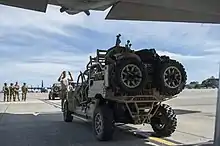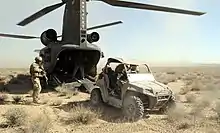Polaris RZR
The Polaris RZR (pronounced "razor") is a sport side-by-side produced by Polaris Industries. When launched in 2007 as a 2008 model, it was officially known as the Ranger RZR, as it was marketed as a sub-model of the larger, work-oriented Ranger. As the RZR gained popularity, Polaris eventually dropped the Ranger designation and positioned the RZR as a stand-alone model.

RZR models in the US


- RZR 170
- RZR 570
- RZR 800
- RZR S 800
- RZR 900
- RZR S 900
- RZR XP 900
- RZR S 1000
- RZR XP 1000
- RZR XP Turbo
- RZR XP Turbo S
- RZR RS1
- MRZR-2
- MRZR-4
- MRZR-D2
- MRZR-D4
Military use

U.S. Special Operations Command, (US)SOCOM, placed an order with Polaris Defense in September 2013 for up to 1,500 MRZR-2 (2-seat) and MRZR-4 (4-seat) machines.[1] A big drawback of these new small military vehicles was that they retained their original gasoline engines, which are incompatible with standard military JP-8 fuel. In terms of logistics, two different fuel types are undesirable. As few such machines see combat use, and civilian users are uninterested in running them on diesel, an engine change was deemed unlikely.[1]

In November 2016, the U.S. Marine Corps signed a $2.5 million contract with Polaris to deliver 144 MRZR-D vehicles. Called the Utility Task Vehicle (UTV), it is designed to be diesel-powered and can run on JP-8 fuel. The Marines bought the unarmored vehicles because they can fit inside an MV-22 Osprey, enabling them to be deployed from long distances, to provide logistics support to ground combat units, assisting them to travel and transport supplies quicker and easier than previously on foot. The vehicles can carry four marines and have a small cargo bed capable of carrying 1,500 lb (680 kg) of payload. Plans are to field 18 MRZR-Ds per infantry regiment. The vehicles were delivered from late-January to April 2017.[2][3][4]
U.S. Army soldiers with Special Operations Task Force / South also used Commercial Off The Shelf (COTS) Polaris RZR 800 Light Tactical All-Terrain Vehicles (LT-ATV), internally transportable by CH-47 Chinook helicopter, and rapidly off-loadable, during operations in 2010 in the Maruf District, Kandahar Province, Afghanistan.
Fire hazards and recalls

For 2010, developed their own engine for the RZR, known as the ProStar.[5] Unlike the previous engine, which had the exhaust cooled by airflow, the ProStar equipped Polaris connected the engine to the exhaust header pipe in the front of the engine, before making a 180 degree turn and exiting at the rear of the vehicle.[5] This design creates a hot spot directly behind passengers that can degrade components and ignite debris, fuel and plastic panels.[5] Customers soon reported plastic panels between the passengers and the engine were melting and smoking and Polaris' safety director at the time believed the vehicle should be recalled.[5] However, no recall was performed, with Polaris issuing a service bulletin which does not require Polaris to issue notice to consumers or the Consumer Product Safety Commission.[5]
In July 2014, an 11-year-old girl from Texas suffered 3rd and 4th degree burns on 60% of her body when the Polaris she was riding in tipped over and ignited.[6] Her right leg and left foot were later amputated.[6] A 15-year-old girl was killed when the RZR she was a passenger in caught fire in July 2015.[6] In September 2016, two Arizona women were killed when their Polaris tipped over and sparked a fire.[6]
In April 2018, Polaris was fined a record $27.5 million by the Consumer Product Safety Commission (CPSC) for two 2016 late-reporting claims relating to a fire risk.[7] The CPSC alleges Polaris had received reports of 150 RZR fires, including the death of the above-mentioned 15 year old passenger,[8] 11 reports of burn injuries and a fire that burned 10 acres of land, but failed to immediately notify them.[7] Over the years, Polaris has recalled more than half a million RZR's for manufacturing defects that could lead to fires, burns or death.[9] However, owners of RZRs are continuing to report fires on vehicles that been previously repaired, including total-loss fires.[9][10]
In May 2019, a 23-year-old man from Idaho suffered fatal burns when the RZR he was riding in burst into flames.,[11] despite the 2017 RZR receiving the repairs under the 2018 recall.[5]
Specifications
| RZR
570 |
RZR
800 |
RZR S
800 |
RZR XP
900 |
RZR XP
1000 |
RZR S 900 | RZR S 1000 | RZR XP
Turbo |
RZR XP
Turbo S |
RZR PRO XP | |
|---|---|---|---|---|---|---|---|---|---|---|
| Model Year Debut | 2012 | 2008 | 2009 | 2011 | 2014 | 2015 | 2016 | 2016 | 2018 | 2020 |
| Horsepower | 45 | 52 | 55 | 88 | 107 | 75 | 100 | 168 | 168 | 181 |
| Displacement (cc) | 567 | 760 | 760 | 875 | 999 | 875 | 999 | 925 | 925 | 925 |
| Width | 50 | 50 | 60 | 64 | 64 | 60 | 60 | 64 | 72 | 64 |
| Wheelbase | 77 | 77 | 77 | 81.4 | 90 | 79 | 79 | 90 | 90 | 96 |
| Length | 107.5 | 102 | 106 | 108 | 119 | 105 | 106 | 119 | 122 | 126 |
| Ground Clearance | 10 | 10 | 12 | 13 | 13.5 | 11 | 12.5 | 13.5 | 16 | 14.5 |
| Front Tire Size | 25 x 8-12 | 25 x 8-12 | 26 x 9-12 | 27 x 9-12 | 29 x 9-14 | 26 x 8-12 | 27 x 9-12 | 29 x 9-14 | 32 x 10-15 | 30 x 10-14 |
| Rear Tire Size | 25 x 10-12 | 25 x 10-12 | 26 x 12-12 | 27 x 11-12 | 29 x 11-14 | 26 x 9-12 | 27 x 11-12 | 29 x 11-14 | 32 x 10-15 | 30 x 10-14 |
| Front Wheel Travel | 9 | 12 | 13.5 | 16 | 10 | 12.25 | 16 | 19 | 17 | |
| Rear Wheel Travel | 9.5 | 12 | 14 | 18 | 10 | 13.2 | 18 | 21 | 20 | |
| Dry Weight (lbs.) | 970 | 945 | 1000 | 1190 | 1379 | 1,148 | 1,235 | 1495 | 1751 | 1749 |
Numbers above are for the first model year available. Units in inches unless otherwise noted. Numbers are manufacturer's where available.
See also
References
- Wheels of the Elite – Jane's Defence Weekly Briefing
- Marine Corps to Equip Infantry Units with Polaris ATVs - DoDBuzz.com, 27 September 2016
- Marine grunts to get new all-terrain vehicles for missions - MarineCorpstimes.com, 22 November 2016
- Marine Grunts Will Start Getting ATVs in January - Defensetech.org, 23 November 2016
- "The Polaris RZR, an Off-Road Thrill That Can Go Up in Flames".
- - fairwarning.org 20 Feb 2018
- - startribune.com, 2 April 2018
- - motleyfool.com 28 Dec 2017
- - motleyfool.com 13 Apr 2017
- - cpsc.gov 19 Dec 2017
- 29 Sept 2019